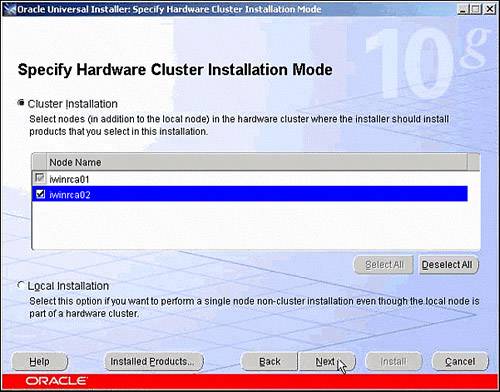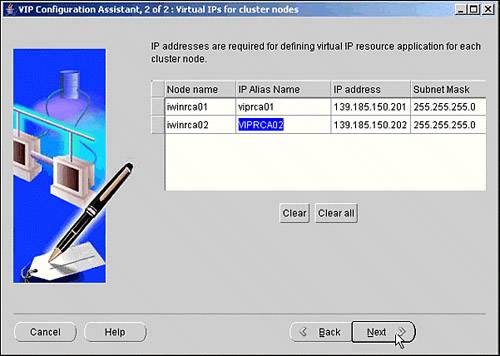10g RAC Manageability Enhancements
| Oracle 10g offers a more mature framework for managing a RAC environment. With the introduction of the new Oracle Cluster Registry to the enhanced RAC support for commonly used database utilities, 10g RAC now supports clusters of up to 64 nodes on all certified platforms. Oracle Cluster RegistryStarting with Oracle 10g, the Oracle 8i and 9i Server Manageability Repository (SRVM) has been redesigned and is referred to as the Oracle Cluster Registry (OCR). The OCR, like its predecessor, is used to maintain the necessary information about the high-availability components in your RAC environment, such as databases, instances, and node information. With the introduction of CRS, the OCR also maintains the information for the required resources defined within CRS such as node applications, services, instances, and databases. During the install of CRS, you are prompted for the location of the OCR and voting disk. If migrating from a previous release, the SRVM will be converted to the OCR. You can place the OCR either on raw devices or shared storage that is managed by a certified cluster file system. Note that in 10g Release 1 neither the OCR nor the voting file for Oracle Clusterware can be stored in ASM. During system startup, CRS will read the contents of the OCR to determine the necessary resources to bring up. Also, due to the redesign and introduction of OCR, the srvConfig.loc configuration file has been renamed the ocr.loc file. Although the OCR primarily manages RAC environments, if you use Automatic Storage Management (ASM) for a single-instance environment, the OCR is also created to serve as a configuration file for ASM. In a RAC environment, there is only one OCR for the entire cluster For a single-instance environment using ASM, however, the OCR is shared for all databases per server. Considered the backbone for RAC manageability, the OCR should always be protected in case of media failure. In 10g Release 1, the OCR and voting disks are not mirrored and rely on protection from third-party redundancy support. You can, however, use a set of new commands that will allow you to back up, restore, export, import, and perform integrity checks against the OCR. Three commands that you can use for cluster repository maintenance include ocrconfig, ocrdump, and ocrcheck. For ocrconfig, you can use the following options for repository maintenance:
The ocrdump command allows you to view the contents of the OCR. ocrdump only has one option, filename, which represents the location and name of the ASCII dump file. The ocrcheck command performs block integrity checks on the OCR and displays valuable information such as the total space used, total space available, and current version. Most of the administration on the OCR is handled implicitly by most of the 10g utilities such as DBCA, EM, and so on during installation and/or configuration. Before modifying the OCR with any of these commands, it is recommended that you review the latest information regarding these utilities from MetaLink and the latest version of the Oracle Real Application Clusters Administrators Guide. Also, if you ever experience a condition wherein you need to repair or restore the OCR, Oracle support has published a very detailed MetaLink note about this process: Note #268937.1, "Repairing or Restoring an Inconsistent OCR in RAC." New Support for 10g UtilitiesNew 10g RAC high-availability (HA) support has been added to many commonly used database utilities. The Server Control (SRVCTL) utility retained all its functionality from 9i Release 2, but now has new commands to support 10g-specific items. SRVCRL is now fully integrated with 10g CRS because the objects managed with SRVCTL are now administrated by CRS. With 10g SRVCTL, you can manage ASM instances, services, and nodeapps. Three new commands provide you the capabilities to manage these new objects with SRVCTL: enable, disable, and relocate. The enable and disable commands record the persistent state in OCR that is used to decide whether the specific resource can run under CRS. The resources used by these commands include services, databases, and instances. The relocate command can be used with services only when moving a workload to another instance within your cluster. The 10g Database Configuration Assistant (DBCA) also has been improved by providing more support for RAC databases. When using 10g DBCA, the first screen will prompt you to choose between creating an Oracle RAC database or an Oracle single-instance database if the CRS stack is properly configured and running (as shown in Figure 15.9). Figure 15.9. Installation method using 10g DBCA. If you do not receive the Oracle RAC option via DBCA, you will need to ensure that CRS is up and running. The next few screens allow you to choose the database options and the nodes to which instances will be created. Also, as shown in Figure 15.10, 10g DBCA gives you three choices for shared storage of your database files: file system (cluster file system for RAC environments), Automatic Storage Management (ASM), or raw devices. Figure 15.10. File-storage options using 10g DBCA. At the end of database creation, DBCA adds the necessary configuration to CRS and the OCR, and configures the listener and VIP end points if they are not present via the VIP configuration assistant (VIPCA). VIPCA is called when you execute root.sh at the end of the database installation (only on the first node; all other nodes will not call VIPCA). You need to enter your virtual IP information via VIPCA, as shown in Figure 15.11. Figure 15.11. Configuring virtual IPs using the 10g VIPCA. Upon successful installation of VIPCA, the necessary services are started on all available nodes within the cluster (as shown in Figure 15.12). Figure 15.12. 10g VIPCA configuration summary. Finally, DBCA now has support to create and manage 10g services, add and remove RAC instances from preconfigured databases, and establish a transparent application failover (TAF) policy for your RAC environment. After using DBCA to create your RAC database, you can verify your install was correct by using the crs_stat utility from the $CRS_HOME/bin directory. You can use crs_stat to confirm that all VIP, GSD, and ONS resources were configured correctly, as well as any database, listener, and instance information for your entire RAC environment. Usually, the naming method for crs_stat uses the ora.hostname.service formatfor example: oracle@ccpfna> $CRS_HOME/bin/crs_stat NAME=ora.ccpfna.gsd TYPE=application TARGET=ONLINE STATE=ONLINE on ccpfna NAME=ora.ccpfna.ons TYPE=application TARGET=ONLINE STATE=ONLINE on ccpfna NAME=ora.ccpfna.vip TYPE=application TARGET=ONLINE STATE=ONLINE on ccpfna ... NAME=ora.ccpfnb.gsd TYPE=application TARGET=ONLINE STATE=ONLINE on ccpfnb NAME=ora.ccpfnb.ons TYPE=application TARGET=ONLINE STATE=ONLINE on ccpfnb NAME=ora.ccpfnb.vip TYPE=application TARGET=ONLINE STATE=ONLINE on ccpfnb ... Managing RAC with 10g Enterprise Manager10g Enterprise Manager (EM) Database Control and Grid Control have been enhanced for better manageability for RAC environments. 10g EM provides consolidated views for monitoring and managing cluster databases at the cluster level. The addition of the new consolidated views provides a better, more manageable environment for DBAs to support Oracle 10g RAC. 10g EM is also intelligent enough to manage node membership, meaning that if nodes are added or removed, 10g EM will update accordingly. In addition to supporting RAC-specific metrics, 10g EM also supports configuration of 10g services and jobs for high availability within a RAC environment. To access the 10g EM Cluster home page, click the Targets tab, click All Targets, and then click the link that represents your cluster name. For more information about 10g EM Database Control or Grid Control, please reference the Oracle 10g Enterprise Manager Concepts guide. |
EAN: 2147483647
Pages: 214